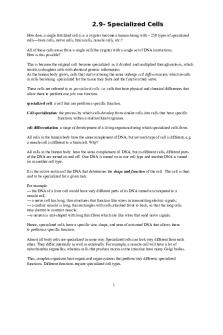White Blood Cells - Grade: A PDF

| Title | White Blood Cells - Grade: A |
|---|---|
| Author | Antonieta Menendez |
| Course | Human Anatomy & Physiology |
| Institution | Hudson Valley Community College |
| Pages | 3 |
| File Size | 62.4 KB |
| File Type | |
| Total Downloads | 51 |
| Total Views | 139 |
Summary
White blood cell types, descriptions, and functions....
Description
1
Assignment #1 White Blood Cells Introduced in Chapter 6 Cardiovascular System: Blood , we learned that white blood cells are classified as either granular leukocytes or agranular leukocytes and are the cells that make up the majority of the immune system. There exist five different types of white blood cells, which have their respective functions within the immune system. Granular leukocytes include neutrophils, eosinophils, and basophils. Neutrophils regard for 50-70% of all white blood cells. They have a multi bodied nucleus, so they are called polymorphonuclear leukocytes. When compared to other granular leukocytes their granules are not easily stained with either acidic red dye or basic purple dye. As noted in our textbook they "are usually the first responders to bacterial infection and their intense phagocytic activity is essential to overcoming an invasion by a pathogen." (p.119) They eliminate germs utilizing a process known as phagocytosis or “cell-eating.” Eosinophils have a bilobed nucleus, whose large, abundant granules take up eosin and display a red color. They are involved in the protection of the body against large parasites and the phagocytosis of the allergens and proteins connected with the inflammatory response. Compared to the others, Basophils are the least frequent type of white blood cell, but they play an essential role in the immune response. They are characterized by a U-shaped or lobed nucleus. In the connective tissues, basophils and similar cells termed mast cells release histamine associated with allergic reactions. Histamine enlarges blood vessels but constricts the air tubes that lead to the lungs, which is what happens when someone has difficulty breathing during an asthma attack.
2 As previously noted Agranular Leukocytes is another category of white blood cells, included here are lymphocytes and monocytes. These do not have granules but have nonlobular nuclei. Because lymphocytes account for 25-35% of all white blood cells, they are responsible for specific immunity to particular pathogens and toxins. We have learned there are two types of lymphocytes, B cells, and T cells. Mature B cells called plasma cells generate antibodies. Some T cells directly destroy pathogens. For instance, the AIDS virus attacks one of the several types of T cells causing immune deficiency; the inability to defend the body against pathogens. Monocytes are regarded as the largest of white blood cells. Following their residence in the tissues, they differentiate into even larger macrophages. Similar to neutrophils, macrophages and dendritic cells are active phagocytes, constantly "destroying pathogens, old cells, and cellular debris" (p. 120) These further stimulate the additional white blood cells including lymphocytes to defend the body. Collectively, white blood cells organize with one another to fight off conditions such as cancer, cellular damage, and infectious diseases.
3
References Mader, S. (2018). Human Biology . McGraw-Hill Higher Education. Mader, S. S. (2018). Laboratory Manual: Human Biology. McGraw-Hill Higher Education....
Similar Free PDFs

White Blood Cells - Grade: A
- 3 Pages

White Blood Cells Abnormalities
- 5 Pages

4. White Blood Cells (Table)
- 2 Pages

White Blood Cell Essay - Grade: 8
- 20 Pages

Blood cells 1 - ghghg
- 1 Pages

White Witch Summary - Grade: A+
- 4 Pages

Disorders of Red Blood Cells
- 14 Pages

Practice Test A 1a white
- 2 Pages

A child - Grade: A
- 5 Pages

Blood
- 30 Pages
Popular Institutions
- Tinajero National High School - Annex
- Politeknik Caltex Riau
- Yokohama City University
- SGT University
- University of Al-Qadisiyah
- Divine Word College of Vigan
- Techniek College Rotterdam
- Universidade de Santiago
- Universiti Teknologi MARA Cawangan Johor Kampus Pasir Gudang
- Poltekkes Kemenkes Yogyakarta
- Baguio City National High School
- Colegio san marcos
- preparatoria uno
- Centro de Bachillerato Tecnológico Industrial y de Servicios No. 107
- Dalian Maritime University
- Quang Trung Secondary School
- Colegio Tecnológico en Informática
- Corporación Regional de Educación Superior
- Grupo CEDVA
- Dar Al Uloom University
- Centro de Estudios Preuniversitarios de la Universidad Nacional de Ingeniería
- 上智大学
- Aakash International School, Nuna Majara
- San Felipe Neri Catholic School
- Kang Chiao International School - New Taipei City
- Misamis Occidental National High School
- Institución Educativa Escuela Normal Juan Ladrilleros
- Kolehiyo ng Pantukan
- Batanes State College
- Instituto Continental
- Sekolah Menengah Kejuruan Kesehatan Kaltara (Tarakan)
- Colegio de La Inmaculada Concepcion - Cebu





